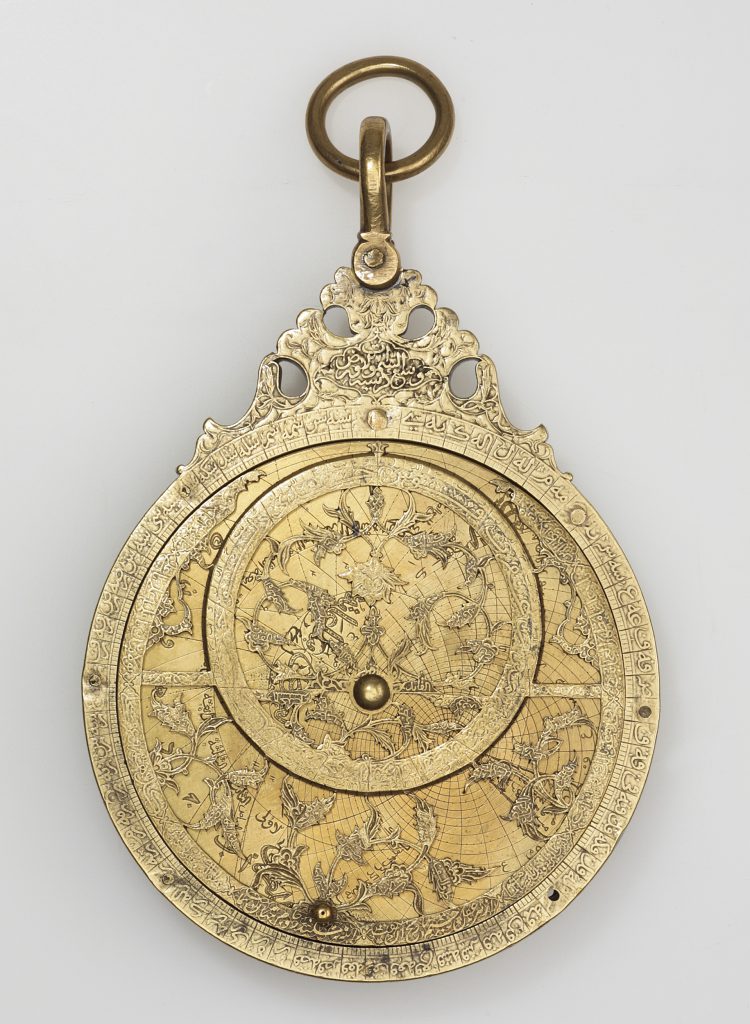



Title: Planispheric Astrolabe
Date: dated 1060 AH (1650–51 AD)
Location: Iran
Materials: brass, sheet and cast, cut and engraved
Dimensions: 14.6 x 11.4 cm, excluding suspension rings
Accession Number: SCI 161
Other Notes:
The astrolabe, an invention of Hellenistic Alexandria, was the principal Islamic instrument for telling the time, surveying and determining latitude. By the later 9th century it was used throughout the Islamic world from Spain to India and later reached Christian Europe. By modelling the apparent rotation of the stars about the celestial pole, it solves a number of astronomical, and astrological, problems. Notably, the provision of a simple sighting device made it possible to calculate the elevation of a particular star, or of the sun, and thus both determine the time and indicate the direction of the North Pole. Moreover, although an astrolabe does not show the movement of the planets, planetary tables enabled the astrologer to know the position of a planet relative to the constellations of the zodiac, which are generally engraved on the plates. The instrument consists of a solid body, the mater, into which fit a series of plates and a revolving circular web-like star map, called the ‘rete’ in Europe and the ‘ankabut (‘spider’) in the Islamic world. The various elements, supplemented by a sighting vane (the alidade), on the back of the instrument, were held together by a pin.
This astrolabe is superbly engraved with a mass of technical information, Qur’anic verses and Persian poetry. The latter includes a chronogram, ‘It is Alexander’s mirror and the cup in which one can see the world’, giving the date 1060 AH (1650–51 AD). Muhammad Mahdi, who worked between 1649 and 1663, came of a family of astrolabists and was responsible for the instrument’s calibration, the most important stage of its manufacture. He provided the astrolabe with plates for five different latitudes with gazetteers of their principal cities.
The survival of so many precisely worked and finely decorated instruments from 17th- and 18th-century Iran is as much testimony to the popularity of astrology at the Safavid court as to an interest in pure astronomy. However, they also reveal a lively interest in European astronomical developments. Muhammad Mahdi’s father met the English traveller Sir John Chardin, who was in Isfahan from 1671 to 1673 and evidently furnished him with recently published French star maps. These Muhammad Mahdi engraved on other astrolabes he made.
Bibliography:
F. Maddison & E. Savage-Smith, Science, Tools & Magic, The Nasser D. Khalili Collection of Islamic Art, volume XII, Part One, London 1997, cat.144, pp.250–51.
J.M. Rogers, The Arts of Islam. Masterpieces from the Khalili Collection, London 2010, cat.367, p.311.
Zoom
Close

Create your own collection of artworks that you can print or save as a PDF. Please enter you email to enable feature.
Planispheric Astrolabe | SCI 161
Has been added to your collection.
TIP:
You can now access and view your collection from the main menu at any time.